Xinpeng Li
Towards Online Multi-Modal Social Interaction Understanding
Mar 25, 2025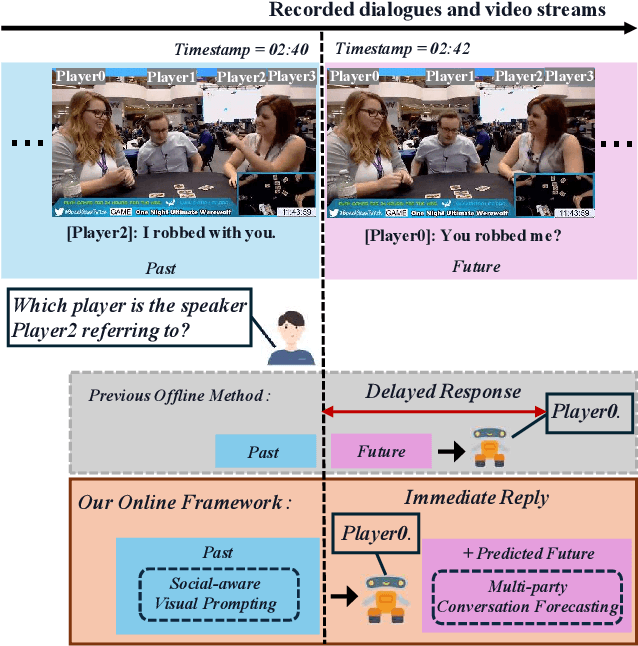
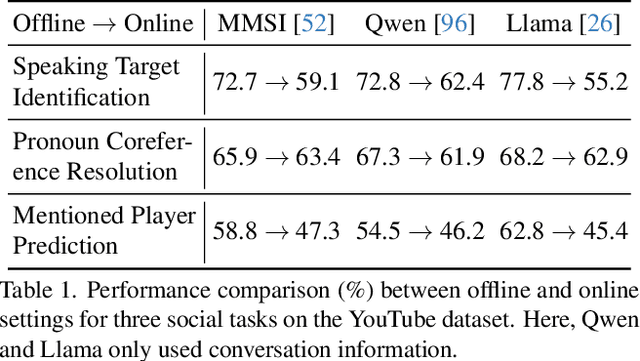
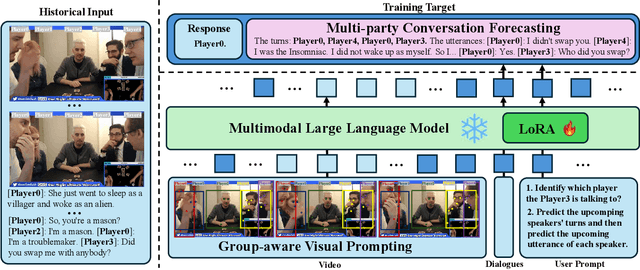
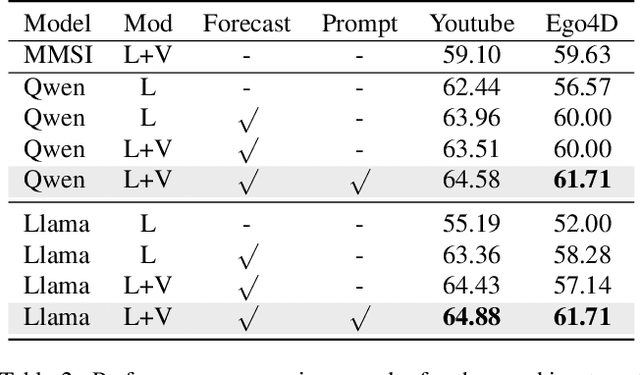
Abstract:Multimodal social interaction understanding (MMSI) is critical in human-robot interaction systems. In real-world scenarios, AI agents are required to provide real-time feedback. However, existing models often depend on both past and future contexts, which hinders them from applying to real-world problems. To bridge this gap, we propose an online MMSI setting, where the model must resolve MMSI tasks using only historical information, such as recorded dialogues and video streams. To address the challenges of missing the useful future context, we develop a novel framework, named Online-MMSI-VLM, that leverages two complementary strategies: multi-party conversation forecasting and social-aware visual prompting with multi-modal large language models. First, to enrich linguistic context, the multi-party conversation forecasting simulates potential future utterances in a coarse-to-fine manner, anticipating upcoming speaker turns and then generating fine-grained conversational details. Second, to effectively incorporate visual social cues like gaze and gesture, social-aware visual prompting highlights the social dynamics in video with bounding boxes and body keypoints for each person and frame. Extensive experiments on three tasks and two datasets demonstrate that our method achieves state-of-the-art performance and significantly outperforms baseline models, indicating its effectiveness on Online-MMSI. The code and pre-trained models will be publicly released at: https://github.com/Sampson-Lee/OnlineMMSI.
An Online Automatic Modulation Classification Scheme Based on Isolation Distributional Kernel
Oct 03, 2024



Abstract:Automatic Modulation Classification (AMC), as a crucial technique in modern non-cooperative communication networks, plays a key role in various civil and military applications. However, existing AMC methods usually are complicated and can work in batch mode only due to their high computational complexity. This paper introduces a new online AMC scheme based on Isolation Distributional Kernel. Our method stands out in two aspects. Firstly, it is the first proposal to represent baseband signals using a distributional kernel. Secondly, it introduces a pioneering AMC technique that works well in online settings under realistic time-varying channel conditions. Through extensive experiments in online settings, we demonstrate the effectiveness of the proposed classifier. Our results indicate that the proposed approach outperforms existing baseline models, including two state-of-the-art deep learning classifiers. Moreover, it distinguishes itself as the first online classifier for AMC with linear time complexity, which marks a significant efficiency boost for real-time applications.
Two in One Go: Single-stage Emotion Recognition with Decoupled Subject-context Transformer
Apr 29, 2024Abstract:Emotion recognition aims to discern the emotional state of subjects within an image, relying on subject-centric and contextual visual cues. Current approaches typically follow a two-stage pipeline: first localize subjects by off-the-shelf detectors, then perform emotion classification through the late fusion of subject and context features. However, the complicated paradigm suffers from disjoint training stages and limited interaction between fine-grained subject-context elements. To address the challenge, we present a single-stage emotion recognition approach, employing a Decoupled Subject-Context Transformer (DSCT), for simultaneous subject localization and emotion classification. Rather than compartmentalizing training stages, we jointly leverage box and emotion signals as supervision to enrich subject-centric feature learning. Furthermore, we introduce DSCT to facilitate interactions between fine-grained subject-context cues in a decouple-then-fuse manner. The decoupled query token--subject queries and context queries--gradually intertwine across layers within DSCT, during which spatial and semantic relations are exploited and aggregated. We evaluate our single-stage framework on two widely used context-aware emotion recognition datasets, CAER-S and EMOTIC. Our approach surpasses two-stage alternatives with fewer parameter numbers, achieving a 3.39% accuracy improvement and a 6.46% average precision gain on CAER-S and EMOTIC datasets, respectively.
Real3D-AD: A Dataset of Point Cloud Anomaly Detection
Sep 26, 2023Abstract:High-precision point cloud anomaly detection is the gold standard for identifying the defects of advancing machining and precision manufacturing. Despite some methodological advances in this area, the scarcity of datasets and the lack of a systematic benchmark hinder its development. We introduce Real3D-AD, a challenging high-precision point cloud anomaly detection dataset, addressing the limitations in the field. With 1,254 high-resolution 3D items from forty thousand to millions of points for each item, Real3D-AD is the largest dataset for high-precision 3D industrial anomaly detection to date. Real3D-AD surpasses existing 3D anomaly detection datasets available regarding point cloud resolution (0.0010mm-0.0015mm), 360 degree coverage and perfect prototype. Additionally, we present a comprehensive benchmark for Real3D-AD, revealing the absence of baseline methods for high-precision point cloud anomaly detection. To address this, we propose Reg3D-AD, a registration-based 3D anomaly detection method incorporating a novel feature memory bank that preserves local and global representations. Extensive experiments on the Real3D-AD dataset highlight the effectiveness of Reg3D-AD. For reproducibility and accessibility, we provide the Real3D-AD dataset, benchmark source code, and Reg3D-AD on our website:https://github.com/M-3LAB/Real3D-AD.
MEFLUT: Unsupervised 1D Lookup Tables for Multi-exposure Image Fusion
Sep 21, 2023Abstract:In this paper, we introduce a new approach for high-quality multi-exposure image fusion (MEF). We show that the fusion weights of an exposure can be encoded into a 1D lookup table (LUT), which takes pixel intensity value as input and produces fusion weight as output. We learn one 1D LUT for each exposure, then all the pixels from different exposures can query 1D LUT of that exposure independently for high-quality and efficient fusion. Specifically, to learn these 1D LUTs, we involve attention mechanism in various dimensions including frame, channel and spatial ones into the MEF task so as to bring us significant quality improvement over the state-of-the-art (SOTA). In addition, we collect a new MEF dataset consisting of 960 samples, 155 of which are manually tuned by professionals as ground-truth for evaluation. Our network is trained by this dataset in an unsupervised manner. Extensive experiments are conducted to demonstrate the effectiveness of all the newly proposed components, and results show that our approach outperforms the SOTA in our and another representative dataset SICE, both qualitatively and quantitatively. Moreover, our 1D LUT approach takes less than 4ms to run a 4K image on a PC GPU. Given its high quality, efficiency and robustness, our method has been shipped into millions of Android mobiles across multiple brands world-wide. Code is available at: https://github.com/Hedlen/MEFLUT.
SAM-IQA: Can Segment Anything Boost Image Quality Assessment?
Jul 10, 2023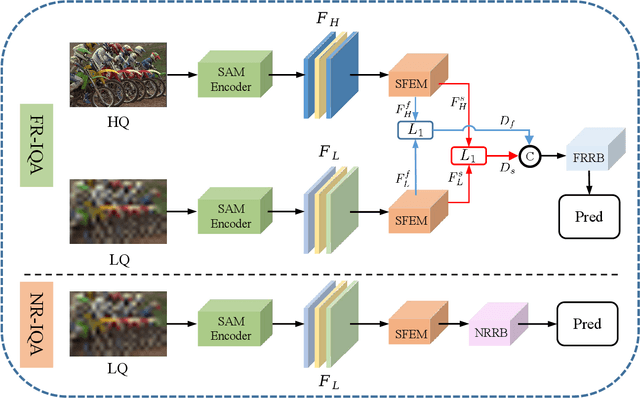
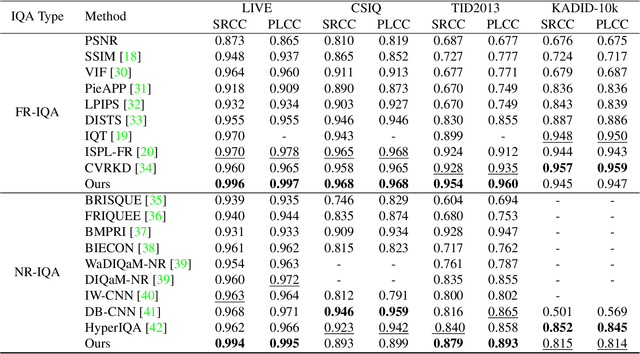
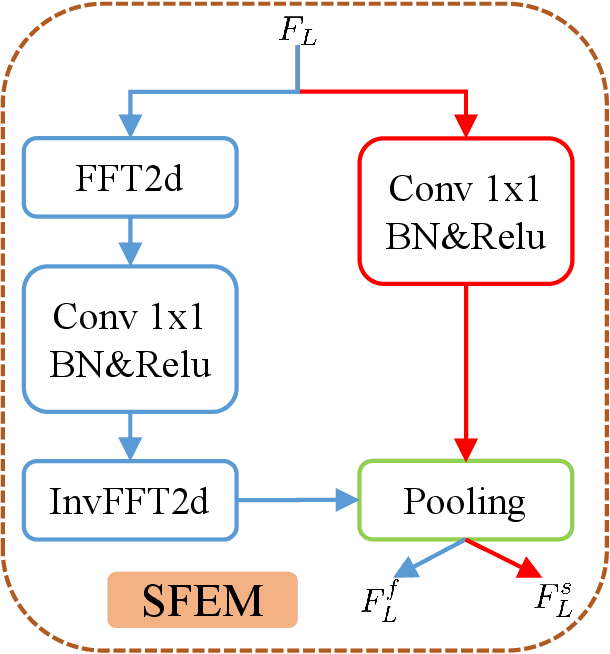

Abstract:Image Quality Assessment (IQA) is a challenging task that requires training on massive datasets to achieve accurate predictions. However, due to the lack of IQA data, deep learning-based IQA methods typically rely on pre-trained networks trained on massive datasets as feature extractors to enhance their generalization ability, such as the ResNet network trained on ImageNet. In this paper, we utilize the encoder of Segment Anything, a recently proposed segmentation model trained on a massive dataset, for high-level semantic feature extraction. Most IQA methods are limited to extracting spatial-domain features, while frequency-domain features have been shown to better represent noise and blur. Therefore, we leverage both spatial-domain and frequency-domain features by applying Fourier and standard convolutions on the extracted features, respectively. Extensive experiments are conducted to demonstrate the effectiveness of all the proposed components, and results show that our approach outperforms the state-of-the-art (SOTA) in four representative datasets, both qualitatively and quantitatively. Our experiments confirm the powerful feature extraction capabilities of Segment Anything and highlight the value of combining spatial-domain and frequency-domain features in IQA tasks. Code: https://github.com/Hedlen/SAM-IQA
DIPNet: Efficiency Distillation and Iterative Pruning for Image Super-Resolution
Apr 14, 2023


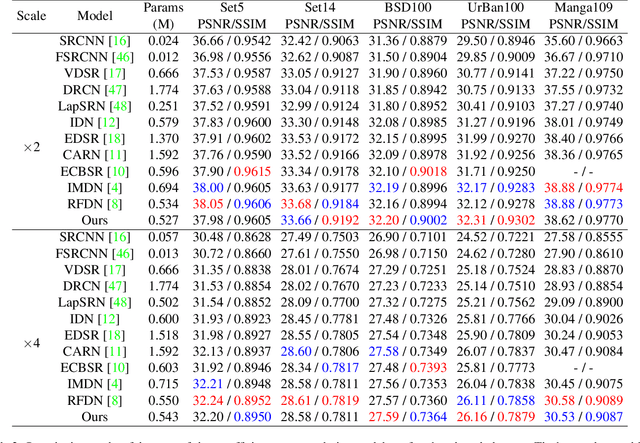
Abstract:Efficient deep learning-based approaches have achieved remarkable performance in single image super-resolution. However, recent studies on efficient super-resolution have mainly focused on reducing the number of parameters and floating-point operations through various network designs. Although these methods can decrease the number of parameters and floating-point operations, they may not necessarily reduce actual running time. To address this issue, we propose a novel multi-stage lightweight network boosting method, which can enable lightweight networks to achieve outstanding performance. Specifically, we leverage enhanced high-resolution output as additional supervision to improve the learning ability of lightweight student networks. Upon convergence of the student network, we further simplify our network structure to a more lightweight level using reparameterization techniques and iterative network pruning. Meanwhile, we adopt an effective lightweight network training strategy that combines multi-anchor distillation and progressive learning, enabling the lightweight network to achieve outstanding performance. Ultimately, our proposed method achieves the fastest inference time among all participants in the NTIRE 2023 efficient super-resolution challenge while maintaining competitive super-resolution performance. Additionally, extensive experiments are conducted to demonstrate the effectiveness of the proposed components. The results show that our approach achieves comparable performance in representative dataset DIV2K, both qualitatively and quantitatively, with faster inference and fewer number of network parameters.
Rail Detection: An Efficient Row-based Network and A New Benchmark
Apr 12, 2023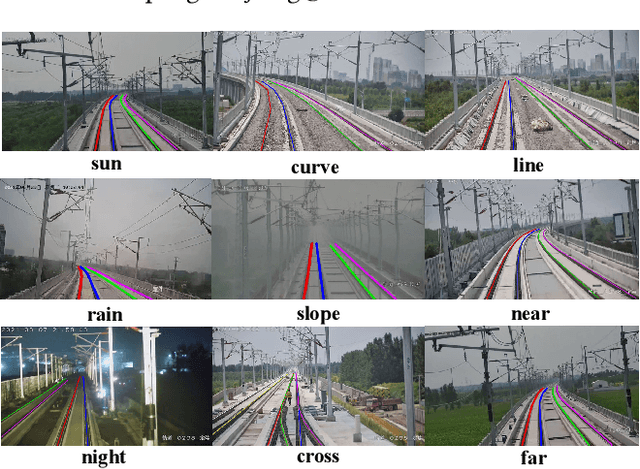

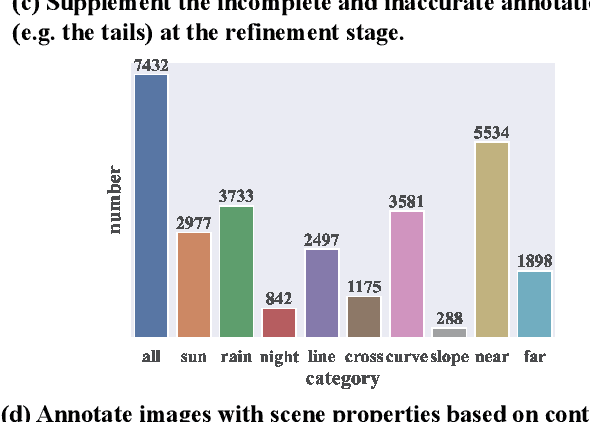

Abstract:Rail detection, essential for railroad anomaly detection, aims to identify the railroad region in video frames. Although various studies on rail detection exist, neither an open benchmark nor a high-speed network is available in the community, making algorithm comparison and development difficult. Inspired by the growth of lane detection, we propose a rail database and a row-based rail detection method. In detail, we make several contributions: (i) We present a real-world railway dataset, Rail-DB, with 7432 pairs of images and annotations. The images are collected from different situations in lighting, road structures, and views. The rails are labeled with polylines, and the images are categorized into nine scenes. The Rail-DB is expected to facilitate the improvement of rail detection algorithms. (ii) We present an efficient row-based rail detection method, Rail-Net, containing a lightweight convolutional backbone and an anchor classifier. Specifically, we formulate the process of rail detection as a row-based selecting problem. This strategy reduces the computational cost compared to alternative segmentation methods. (iii) We evaluate the Rail-Net on Rail-DB with extensive experiments, including cross-scene settings and network backbones ranging from ResNet to Vision Transformers. Our method achieves promising performance in terms of both speed and accuracy. Notably, a lightweight version could achieve 92.77% accuracy and 312 frames per second. The Rail-Net outperforms the traditional method by 50.65% and the segmentation one by 5.86%. The database and code are available at: https://github.com/Sampson-Lee/Rail-Detection.
AU-Aware Vision Transformers for Biased Facial Expression Recognition
Nov 12, 2022



Abstract:Studies have proven that domain bias and label bias exist in different Facial Expression Recognition (FER) datasets, making it hard to improve the performance of a specific dataset by adding other datasets. For the FER bias issue, recent researches mainly focus on the cross-domain issue with advanced domain adaption algorithms. This paper addresses another problem: how to boost FER performance by leveraging cross-domain datasets. Unlike the coarse and biased expression label, the facial Action Unit (AU) is fine-grained and objective suggested by psychological studies. Motivated by this, we resort to the AU information of different FER datasets for performance boosting and make contributions as follows. First, we experimentally show that the naive joint training of multiple FER datasets is harmful to the FER performance of individual datasets. We further introduce expression-specific mean images and AU cosine distances to measure FER dataset bias. This novel measurement shows consistent conclusions with experimental degradation of joint training. Second, we propose a simple yet conceptually-new framework, AU-aware Vision Transformer (AU-ViT). It improves the performance of individual datasets by jointly training auxiliary datasets with AU or pseudo-AU labels. We also find that the AU-ViT is robust to real-world occlusions. Moreover, for the first time, we prove that a carefully-initialized ViT achieves comparable performance to advanced deep convolutional networks. Our AU-ViT achieves state-of-the-art performance on three popular datasets, namely 91.10% on RAF-DB, 65.59% on AffectNet, and 90.15% on FERPlus. The code and models will be released soon.
AU-Supervised Convolutional Vision Transformers for Synthetic Facial Expression Recognition
Jul 22, 2022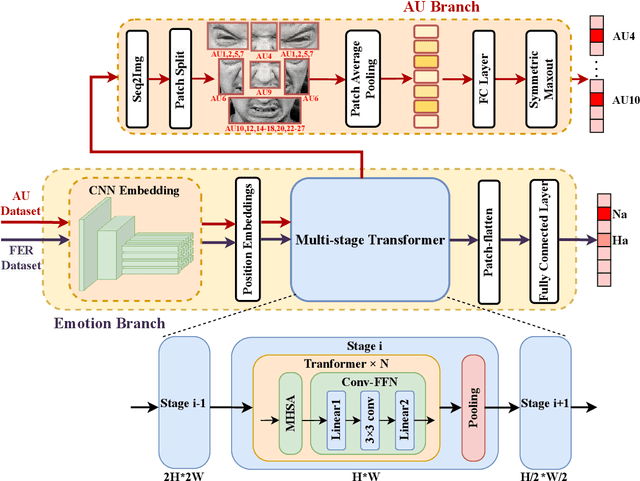
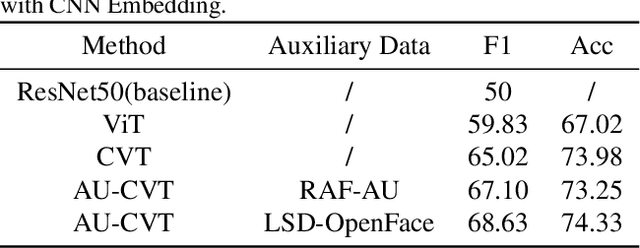
Abstract:The paper describes our proposed methodology for the six basic expression classification track of Affective Behavior Analysis in-the-wild (ABAW) Competition 2022. In Learing from Synthetic Data(LSD) task, facial expression recognition (FER) methods aim to learn the representation of expression from the artificially generated data and generalise to real data. Because of the ambiguous of the synthetic data and the objectivity of the facial Action Unit (AU), we resort to the AU information for performance boosting, and make contributions as follows. First, to adapt the model to synthetic scenarios, we use the knowledge from pre-trained large-scale face recognition data. Second, we propose a conceptually-new framework, termed as AU-Supervised Convolutional Vision Transformers (AU-CVT), which clearly improves the performance of FER by jointly training auxiliary datasets with AU or pseudo AU labels. Our AU-CVT achieved F1 score as $0.6863$, accuracy as $0.7433$ on the validation set. The source code of our work is publicly available online: https://github.com/msy1412/ABAW4
 Add to Chrome
Add to Chrome Add to Firefox
Add to Firefox Add to Edge
Add to Edge